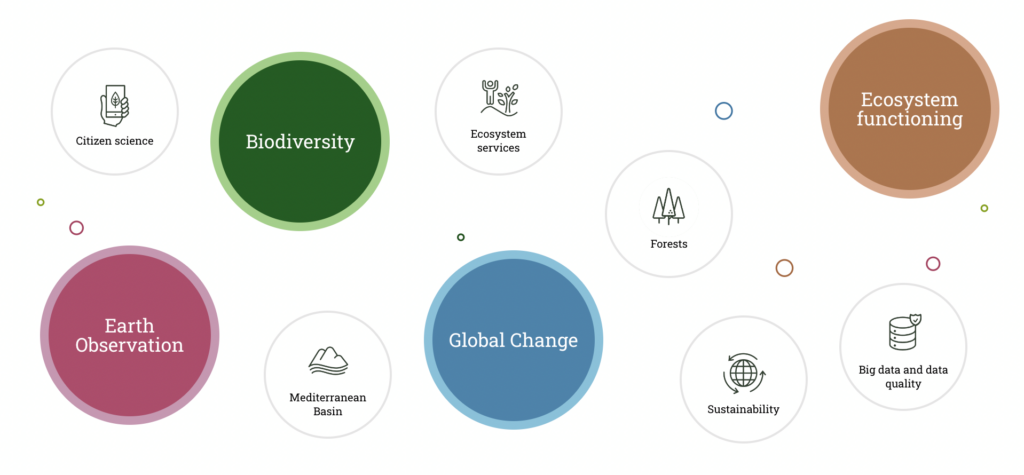
Contact persons:
Enrique Doblas Miranda
Transfer Officer

Burcu Berk
Research Officer on Ecosystem Services

Javier Albarracin
Mediterranean Advisor

LIVING LAB 8: Spain
CREAF & EMEA Collaboration
Motivation
- Establishing a living lab focused on agroforestry sector finance and policy requires a holistic and collaborative approach, combining research, expert engagement, and policy advocacy;
- The living lab will be part of a network of researchers and agroforestry stakeholders, and can strengthen its scientific collaboration and research capacity related to policy and finance;
- The living lab will engage with stakeholders in the financial sector and with policy makers, both as part of the ReForest working group series which will meet 3 times a year, but can support activities with other projects to widen its impact;
- For ReForest, this living lab will enhance the co-creation process supporting the deliverables of WP5 “Finance and Policy”, e.g., on the mapping reports on agroforestry sector finance and policy, and on the development of the sustainable financing scheme for agroforestry based on payments for ecosystem services provided by agroforestry systems (Year: 2024). The living lab can also contribute to the development of policy recommendations at a later date (Years: 2025-2026);
- The living lab can use its participation in ReForest to deepen its research and enhance its knowledge of agriculture and forestry;
- Provide opportunities for future collaborative activities (e.g., EU projects, academic and policy papers).
- Collaboration and creation of synergies between projects and activities
- Added value as a collaborative platform, looking to generate critical mass in analysis of agriculture, forestry and agroforestry finance
- Create an opportunity for research projects and initiatives to utilise the research and impact potential of ReForest
CREAF and its working activities
CREAF, the Center for Ecological Research and Forestry Applications, is a prominent public research center with a primary focus on terrestrial ecology, territorial analysis, and global change.
Committed to excellence, CREAF operates at the intersection of education, administrations, and society. Their mission revolves around contributing to environmental and territorial conservation by addressing adaptation to changing environments on local, regional, and global scales. Through a blend of basic and applied research, CREAF strives to be a national and international reference in ecological studies, especially in the field of forestry. CREAF develops methodological tools to facilitate decision-making and enhance environmental management, disseminating their findings through training, consulting, and educational initiatives. CREAF envisions a future where their research not only contributes to environmental knowledge but also leads to practical applications that improve conservation and management strategies.
Global impact of research
We have a broad and multidisciplinary research portfolio, integrating fundamental research advances with important contributions in environmental issues of great socioeconomic impact.

Mission, Objectives and Vision
Mission
The center strives to contribute to knowledge on conservation and management of the environment and the territory, in addition to adaptation to environmental change at local, regional, and global scales, functioning as a bridge between academia, administrations, and society, and promoting awareness within its scope of activities.
Objectives
- Carry out excellent, innovative, and leading basic research so as to be considered as a reference at the national and international levels.
- Promote applied research, especially in the area of forestry, contributing to the sustainable management and conservation of resources and ecosystems.
- Develop conceptual and methodological tools to facilitate decision-making and improve management of the environment.
- Disseminate scientific and technological knowledge by way of training, consulting, or educative activities.
Vision
- Carry out excellent research and development which contribute to knowledge about natural systems and which is applicable to improving conservation and management of the environment and territory.
- Achieve CREAF’s leadership at the national level and growing recognition at the international level.
- Position the CREAF as a center of reference for terrestrial ecology, territorial analysis, and global change in the Mediterranean basin.
- Expand synergies between scientific research and technological development to address the necessities of environmental management and land use planning within public administrations and the private sector.
- Lessen dependence on political dispositions, employing efficient management and an elevated capacity for obtaining resources and maintaining financial stability.
- Be constituted of personnel whom share the mission of the center and are active in achieving its vision, and having flexible organization favoring collaboration and the permeability of its research groups.
- Be more visible within the scientific community, administrations, and society in general in order to have more weight in debate and decision-making related to environmental issues.
- Exercise workplace values based on ethics, cooperation, equal opportunity, and environmental responsibility.
Research goals
CREAF’s mission is to generate knowledge to understand nature, identify potential threats, and develop solutions to address environmental and climate challenges at local, national, and global level. CREAF is deeply committed to promoting a culture of impact in research and to fostering the mobilization, uptake and use of its research findings in the non-academic world to deliver positive impact.
Research fields
- Biodiversity
- Ecosystem functioning
- Global change
- Earth observation
Transversal topics
- Forests
- Mediterranean Basin
- Ecosystem services
- Sustainability
- Citizen science
- Big data
Products and services
Research, monitoring and observation are our tool to generate environmental knowledge and information. We also use environmental change models and scenario development to understand and support decision-making processes.
CREAF collaborates in environmental management programs and tests innovative systems and practices that facilitate local, national and international cooperation in this area.
We offer a wide range of products and services tailored to entities, companies or administrations that perform activities related to the environment.
Forest management services
CREAF offers services and tools for forest management intended for the evaluation of forest resources, planning the sustainable use of biomass, understanding regeneration potential after wildfire, or testing management strategies adapted to global change.
Over the past few years, various emblematic projects have demonstrated the experience and quality of the services offered by CREAF in this field.
- Support to forest management
- Forest inventory design
- Ecological monitoring networks
- Risk and impact studies in forest areas
Land-use planning services
Many of the products and services offered by CREAF are tools which aid in proper land-use planning adapted to social, economic, and environmental requirements and limitations, always taking into consideration appropriateness to the locality and age we live in. At CREAF we can carry out complete territorial analyses using environmental databases, remote sensing, GIS, aerial photography and cartographic databases.
- Environmental and territorial analysis
- Strategic plans and consulting
- Thematic digital cartography
- Environmental information systems (EIS)
- Studies of environmental risk
Sustainable water management services
Numerous projections forecast that the Mediterranean will be one of the planet’s regions most vulnerable to global environmental change. This phenomenon will affect water availability and as a consequence the functioning of natural ecosystems, agriculture, the quantity of water, and social and economic activities.
At CREAF we collaborate in the design of water scarcity adaptation measures, the evaluation of climate change impacts on water resources, the study of the water cycle via satellite imagery, and inspection of water quality in watersheds.
- Water and global change
- Wastewater
- Study of the water cycle using remote sensing
- Water quality and environmental inspection
Soil protection and rehabilitation services
At CREAF we have long-established experience in the protection and rehabilitation of degraded soils and the reutilization of sewage sludge for the restoration of lands affected by extractive activities. Based on this experience we have elaborated protocols which help optimize the restoration process.
Our services are addressed to professionals associated with the restoration of spaces affected by mining, territorial managers, agriculturists, managers of waste management plants, and administration technicians dedicated to soil protection.
- Technical and testimonial expert soil reports
- Ecotoxicological studies
- Restoration of quarries and other degraded spaces
- Soil Analysis
Forest fire management services
CREAF collaborates with different entities in forest fire prevention, proposing and practicing forest management measures to reduce the risk and impact of large wildfires, and developing knowledge and cartography to improve the predictive capacity of wildfire risk assessment.
At CREAF, we have a great deal of experience collaborating with different entities to plan the management of burnt areas. The objective of such management is often to immediately reduce new wildfire risk (being the case that the shrubbery which grows afterwards is especially prone to fire) and improve the recovery capacity of the habitat.
- Prevention and management of forest fires
- Risks and impacts of fire
- Management of burned areas
GIS and remote sensing services
A geographic information system (GIS) is a scientific and technological tool in the form of a computing application which allows the generation and management of digital thematic and topographic maps, aerial photographs, satellite images, digital terrain models, large databases and also the ability to connect to GPS systems. It is an indispensable tool for decision-making, taking into account aspects of territorial dynamics such as urban growth, forest fires and other risks, etc.
The GIS system MiraMon has been in development since late 1994. Notable to this system is the wide spectrum of applications, the scientific rigor used in its implementation, and its ease of use, which has converted it into a tool of habitual use in research, territorial management and planning of numerous public institutions, universities, and companies within the sector. All of these capacities make MiraMon an extraordinary instrument in diverse areas of research, planning, and territorial management.
- GIS analysis, terrain modeling and analysis
- Definition and application of information organization standards
- Implementation of GIS projects
- Geographic information system MiraMon
- Remote sensing
Biodiversity conservation services
At CREAF we carry out studies on ecosystem function and the roles of species, populations, and communities of organisms in defining environmental constraints. These studies are vital for managing and conserving biodiversity.
Our services are addressed to professional experts in management of protected areas and biological resources, to environmental departments of large companies, or researchers at institutions with activities that are academic, ecological, biological or environmental in nature.
- Biodiversity monitoring networks
- Biodiversity and global change
- Studies of environmental risk to terrestrial biodiversity
- Landscape and biodiversity
- Species monitoring
Forests
Forests are the most prominent and influential terrestrial ecosystems on the planet. They cover approximately 30% of the Earth’s surface and are found on all of the continents. They contain 80% of terrestrial ecosystem’s plant biomass and account for 75% of gross primary productivity. Forests provide a large number of ecosystem services which are vital for society. They absorb and fix carbon, play a key role in the regulation of water resources, and curb erosion and desertification processes. They also help regulate gas exchange, produce wood, and favor the conservation of biodiversity and habitats. However, global change has significantly modified the structure, composition and functioning of forest ecosystems. Forests are being affected by different natural processes and disturbances, such as forest fires, acid rain, drought, and pests, as well as different forest management regimes.
In this area, CREAF focuses its research on the structure, dynamics and functioning of forests. In particular, we study the decline, regeneration and global functioning of forests by studying nutrient and water cycles and uses. In addition, we develop mathematical models, carry out forest inventories, and create databases. The results of this research are used to plan and improve sustainable forest management strategies that allow us to preserve the natural, social and economic value of forests.
The main lines of work and expertise of CREAF in this field include:
- Forest dynamics: We analyze forest dynamics and long-term changes in the structure, composition and functioning of these ecosystems. For this work we carry out forestry inventories which are repeated over time, or we design targeted programs to monitor forest health.
- C stocks and flows: We identify the patterns of distribution of carbon stocks and flows in forests.
- Water economy: We identify the ecological factors regulating the water economy of woody plants.
- Nutrient cycles: We study forest nutrient cycles and uses and changes in each.
- Functional traits: We characterize the global patters of functional trait distributions in both plants and animals.
- Animal communities: We study the effects of forest dynamics on animal communities.
- Vulnerabilities to climate change: We study the vulnerability of forest ecosystems to disturbances and climate change.
- Metabolomics: Using metabolomic techniques, we study the adaptive responses of forests to global change.
- Forest-atmosphere: We study forest-atmosphere relationships and how these are modified with global change.
- Modeling: We create models of forest dynamics under different scenarios of climate, disturbances, and changes in use.
- Ecosystem services: We develop indicators to measure the ecosystem services provided by forests.
- Sustainable forest management: We design and implement sustainable forest management measures to reduce forests’ vulnerability to environmental impacts.
- Adaptation of forests to climate change: We propose forest adaptation strategies so that they will be able to cope with extreme climatic phenomena and climate change.
Ecosystem services
Ecosystem or environmental services are those services resulting from ecosystem function which are of utility to society, promoting wellbeing. Examples are the production of clean water, soil formation, climate regulation by forests, pollination, etc. Though many of these services go unnoticed, they must be conserved because they support human health, economy, and quality of life. When they are not adequately preserved their degradation is accompanied by serious negative affects for human wellbeing.
For this reason, ecosystem services are increasingly being moved to the center of national and European policies, and used as indicators of the quality of society’s interaction with the environment. The next step is to place ecosystem services in the centre of decision-making and environmental policies. Once this is done we will have the tools to identify what management options can help mitigate the effects of global change, optimize the benefits, and avoid costs and potential risks to ecosystems and societies.
- Social and ecological vulnerability: We identify the ecosystem services of watersheds in order to establish adaptation measures which increase their resilience.
- Definition, evaluation and mapping of biophysical indicators: We measure the main functions and ecosystem services of forests, including provisioning services (mushrooms, fresh water), regulating services (carbon sink capacity of forests, water regulation), cultural services (nature tourism) and support services (biodiversity).
- Prediction and models:We formulate predictions of climate change’s impacts ecosystem services and their adaptation, with particular attention to extreme climatic phenomena. To accomplish this we integrate models for land use change, forests, and the landscape.
- Remote sensing and GIS: Using remote sensing data (MODIS, Landsat, Sentinel, etc.), we conduct monitoring over time and space and create cartographic products for ecosystem service indicators.
- Synergies and trade-offs: We analyze synergies and trade-offs between different ecosystem services on the ground (spatial relationships) and with time (temporal relationships), also taking into account relationships between flows of service supply and demand.
- Soil microorganisms: We study the services offered by soil microorganisms, including the regulation of some terrestrial biogeochemical cycles such as the retention and release of N and C.
- Citizen science: We develop ecosystem service indicators using citizen science. These projects generate data on a large scale and can be based on standardized methodologies as well as opportunistic observations. The indicators developed range from support and regulating services to cultural services.
- Pollinator communities: We study pollinator communities providing the pollination service. We analyze the relationships between these communities and fruit and seed production in natural environments as well as agricultural systems.
- Pests: We study the community of insects which can act as natural enemies of fruit tree pests.







